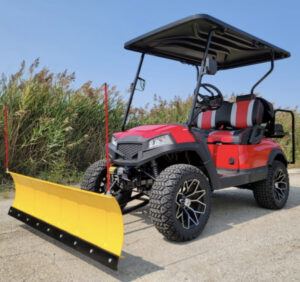
Knowing how to winterize a golf cart will help increase the lifespan of your investment. To do so, you’ll need to take a few key steps to protect it from the cold weather and ensure it remains in good condition during the winter months.
So, we’ll walk you through the essential steps of winterizing your golf cart, ensuring that it remains in optimal condition throughout the colder months. From prepping the vehicle for storage to protecting it from the elements and performing necessary maintenance tasks, we’ve got you covered.
As the vibrant colors of autumn fade away and the chill of winter sets in, it’s time for golf cart owners to turn their attention to a crucial aspect of vehicle maintenance: winterization. While golf carts are typically associated with sunny days on the course, neglecting to prepare them for the harsh realities of winter can lead to a host of issues and costly repairs down the line.
Therefore, whether you’re a seasoned golf cart enthusiast or a new owner looking to safeguard your investment, mastering the art of winterization is key to extending the lifespan and performance of your beloved ride.
Preparing Your Golf Cart for Winter Storage
Before tucking your golf cart away for the winter, it’s essential to ensure that it’s in prime condition and ready to withstand the cold months ahead. Follow these steps to prepare your golf cart for winter storage.
Start by giving your golf cart a thorough cleaning, both inside and out. Remove any dirt, debris, and grass clippings that may have accumulated during use. Pay special attention to the undercarriage and wheel wells, as salt and grime can cause corrosion over time.
Next, conduct a detailed inspection of your golf cart to identify any existing issues or potential areas of concern. Check for signs of wear and tear, such as loose bolts, worn-out tires, or corroded battery terminals. Addressing these issues now can prevent them from worsening during storage.
Additionally, proper battery maintenance is crucial for ensuring that your golf cart starts up smoothly when spring rolls around. Clean the battery terminals with a wire brush and a mixture of baking soda and water to remove any corrosion. Then, fully charge the batteries and consider disconnecting them to prevent drain during storage.
To continue, before storing your golf cart for an extended period, it’s essential to stabilize the fuel to prevent it from breaking down and causing engine issues. Add a fuel stabilizer to the gas tank according to the manufacturer’s instructions, and run the engine for a few minutes to ensure that the stabilizer circulates throughout the fuel system.
Also, performing an oil change before winter storage is a simple yet effective way to protect your golf cart’s engine from damage. Old oil can contain contaminants that may cause corrosion or hinder proper lubrication. Consult your owner’s manual for the recommended oil type and change interval, and be sure to dispose of the used oil properly.
By following these steps to prepare your golf cart for winter storage, you can rest assured that it will remain in optimal condition until it’s time to hit the links again in the spring. Taking the time to properly clean, inspect, and maintain your golf cart now can save you from headaches and costly repairs down the road.
Protecting Your Golf Cart from the Elements
Once you’ve prepared your golf cart for winter storage, the next step is to shield it from the harsh elements that accompany the colder months. Here are some tips for protecting your golf cart from the elements.
First, choosing the right storage option is crucial for keeping your golf cart safe and secure during the winter. If possible, store your golf cart indoors in a garage or storage shed to shield it from snow, ice and freezing temperatures. If indoor storage isn’t available, consider using a golf cart cover or tarp to protect it from the elements.
Furthermore, proper tire care is essential for maintaining the performance and longevity of your golf cart’s tires during winter storage. Before storing your golf cart, inflate the tires to the recommended pressure to prevent flat spots from forming. Additionally, consider using tire covers to shield the tires from UV rays and other environmental hazards.
Winter weather, particularly snow and road salt, can accelerate corrosion and rust on your golf cart’s metal components. To protect your golf cart from rust, apply a rust inhibitor or protective coating to vulnerable areas such as the frame, chassis and undercarriage. Regularly inspect these areas throughout the winter and touch up any areas where the coating has worn away.
Also, if your golf cart is equipped with a windshield, take steps to protect it from damage during the winter months. Consider installing a windshield cover or protective film to prevent scratches, cracks, and chips caused by debris or ice buildup. Additionally, avoid using sharp objects or abrasive materials to remove snow and ice from the windshield, as this can cause damage.
Lastly, if your golf cart is exposed to snowfall during the winter, take care when removing snow to avoid damaging the vehicle. Use a soft-bristled brush or snow shovel to gently clear snow from the exterior surfaces, taking care not to scratch or dent the body. Avoid using metal tools or sharp objects that could cause damage to the paint or finish.
By taking proactive measures to protect your golf cart from the elements during the winter months, you can ensure that it remains in top condition and ready for action when spring arrives. Investing a little time and effort now to shield your golf cart from snow, ice and cold temperatures can go a long way toward preserving its appearance and performance for years to come.
Engine and Fuel System Maintenance
Proper engine and fuel system maintenance are vital aspects of winterizing your golf cart to ensure it starts up smoothly when spring arrives. Here’s what you need to know to keep your golf cart’s engine and fuel system in top condition during the winter months.
Fuel Stabilization: Before storing your golf cart for an extended period, it’s essential to stabilize the fuel to prevent it from breaking down and causing engine issues. Adding a fuel stabilizer to the gas tank helps prevent the fuel from oxidizing and forming varnish and gum deposits, which can clog fuel lines and injectors. Follow the manufacturer’s instructions for the correct dosage and ensure the stabilizer is thoroughly mixed with the fuel by running the engine for a few minutes.
Oil Change: Performing an oil change before winter storage is a simple yet effective way to protect your golf cart’s engine from damage. Old oil can contain contaminants that may cause corrosion or hinder proper lubrication, especially in cold temperatures. Consult your owner’s manual for the recommended oil type and change interval, and be sure to dispose of the used oil properly.
Engine Protection: To prevent pests from nesting inside the engine compartment during the winter months, cover air intakes and exhaust pipes with breathable material such as mesh screens. Additionally, consider placing mothballs or rodent repellent around the perimeter of the golf cart to deter pests from taking up residence.
Battery Maintenance: Cold temperatures can cause batteries to lose their charge more quickly, so it’s essential to periodically check and maintain your golf cart’s batteries during the winter months. Keep the batteries fully charged by using a battery maintainer or trickle charger, and consider installing battery blankets or insulation to help retain heat and prevent freezing.
Periodic Maintenance: Even while in storage, it’s essential to periodically check on your golf cart’s engine and fuel system to ensure everything is functioning correctly. Monitor the fuel level and condition regularly, and top up the fuel tank if necessary to prevent moisture accumulation. Additionally, periodically start the engine and let it run for a few minutes to circulate the fuel stabilizer and prevent fuel system issues.
By following these maintenance tips for your golf cart’s engine and fuel system, you can ensure that it remains in optimal condition throughout the winter months and is ready to hit the links again when spring arrives. Taking proactive measures now can save you from costly repairs and prolong the lifespan of your golf cart’s engine and fuel system.
Spring Readiness and Post-Winter Maintenance

As the winter months come to an end and the promise of warmer weather looms on the horizon, it’s time to prepare your golf cart for the upcoming season. Follow these steps to ensure your golf cart is ready to hit the links again.
First and foremost, conduct a thorough inspection of your golf cart to assess its condition after months of storage. Check for any signs of damage, wear, or corrosion that may have occurred during the winter months. Pay close attention to the battery, tires, and exterior surfaces, and address any issues promptly to prevent them from worsening.
Next, perform any necessary maintenance tasks to ensure your golf cart is in optimal working condition. This may include charging the batteries, checking fluid levels, and lubricating moving parts. Additionally, inspect the tires for signs of wear and tear, and inflate them to the recommended pressure if necessary.
Once your golf cart is in top shape, take it for a test drive to ensure everything is functioning correctly. Pay attention to how the vehicle handles and performs, and listen for any unusual noises or vibrations. If you notice any issues, address them promptly to prevent further damage.
Finally, don’t forget to give your golf cart a good cleaning to remove any dirt, debris, or grime that may have accumulated during storage. This will not only improve the appearance of your golf cart but also help maintain its overall condition and performance.
By following these steps for spring readiness and post-winter maintenance, you can ensure that your golf cart is in top condition and ready to tackle the upcoming season with ease. Taking the time to properly inspect, maintain, and clean your golf cart now will pay off in the long run, allowing you to enjoy countless hours of fun on the course without worry.
Steps To Winterize A Gas Golf Cart
1. Clean the golf cart: Thoroughly clean the exterior of the golf cart, including the body, wheels, and underneath, to remove any dirt, debris, or corrosive substances. This step helps prevent damage and keeps the cart looking its best.
2. Check and change fluids: Inspect the fuel, oil, and coolant levels. If any fluids are low or due for a change, top them up or replace them as recommended in the manufacturer’s instructions.
3. Stabilize the fuel: Add a fuel stabilizer to the gas tank to prevent the gasoline from deteriorating and causing problems during storage. Follow the instructions on the stabilizer product for the correct amount to add. **Draining the fuel is also an effective option to protect the gas tank. Make sure all gas is completely removed from the tank if you decide to drain the tank.**
4. Run the engine: Start the engine and let it run for a few minutes to ensure the stabilized fuel circulates through the system and prevents any potential carburetor or fuel line issues.
5. Charge the batteries: If your gas golf cart has batteries for lights or accessories, charge them fully to prevent damage and maintain their performance over the winter. Follow the manufacturer’s instructions for proper charging procedures.
6. Protect the battery: If the golf cart has a separate starter battery, disconnect it to avoid draining during storage. Clean the battery terminals and apply a thin layer of petroleum jelly to prevent corrosion.
7. Store the golf cart indoors: Ideally, store the golf cart in a dry, climate-controlled area like a garage or storage unit. If indoor storage is not available, use a sturdy waterproof cover to protect it from the elements.
8. Inflate the tires: Check the tire pressure and inflate them to the recommended level. Properly inflated tires help prevent flat spots and maintain their shape during storage.
9. Secure the cart: If necessary, engage the parking brake or use wheel chocks to prevent the golf cart from rolling while in storage.
10. Perform periodic maintenance: Even during storage, periodically check on the golf cart to ensure it remains in good condition. Inspect for any signs of damage, leaks, or pests, and address them promptly if necessary.
Following these steps should help ensure that your gas golf cart is properly winterized and protected during the colder months. However, it’s always a good idea to consult your golf cart’s owner’s manual for any specific instructions or recommendations from the manufacturer.
Steps to Winterize an Electric Golf Cart
Winterizing an electric golf cart involves some specific steps to protect the batteries and electrical components from the cold weather. Here’s a guide to help you winterize an electric golf cart:
1. Clean the golf cart: Begin by cleaning the exterior of the golf cart thoroughly, including the body, wheels, and underneath, to remove any dirt, debris, or corrosive substances. This step helps prevent damage and keeps the cart in good condition.
2. Charge the batteries: Make sure the batteries are fully charged before winter storage. This step helps maintain the battery life and prevents them from freezing or losing their charge during the colder months.
3. Disconnect the batteries: Disconnect the battery cables from the battery terminals. This prevents any electrical drain on the batteries and extends their life during storage.
4. Store the batteries properly: If possible, remove the batteries from the golf cart and store them indoors in a dry, cool location. It’s essential to protect them from freezing temperatures. If removing the batteries is not feasible, ensure the storage area is climate-controlled or use battery blankets or insulation to provide some protection against extreme temperatures.
5. Clean battery terminals: Clean the battery terminals with a mixture of baking soda and water or a battery terminal cleaner to remove any corrosion. Dry the terminals thoroughly and apply a thin layer of petroleum jelly or a battery terminal protectant to prevent further corrosion.
6. Check and maintain tire pressure: Inspect the tire pressure and inflate the tires to the recommended level. Properly inflated tires help prevent flat spots and maintain their shape during storage.
7. Protect the golf cart: If storing the cart outdoors, use a high-quality, weatherproof cover to protect it from the elements. Ensure that the cover fits properly and securely for maximum protection.
8. Perform periodic maintenance: During storage, periodically check on the golf cart to ensure it remains in good condition. Inspect for any signs of damage, leaks, or pests and address them promptly if necessary.
Remember to consult the manufacturer’s instructions and recommendations specific to your electric golf cart model for any additional steps or considerations when winterizing. Proper winterization will help protect the electric components and ensure your golf cart is ready for use when the warmer weather returns.
Conclusion
As the winter months close in and the golfing season comes to an end in some areas, taking the time to properly winterize and maintain your golf cart is essential for ensuring its longevity and performance.
By following the steps outlined in this guide, from preparing your golf cart for winter storage to protecting it from the elements and performing necessary maintenance tasks, you can rest assured that your vehicle will be in optimal condition when spring arrives.
So, whether you have a gas powered golf cart or an electric golf cart it is important to perform this maintenance if you live in a cold climate during the winter months.
With proper care and maintenance, your golf cart will be ready to hit the links with confidence, allowing you to enjoy countless rounds of golf in the season ahead.
 Happy Carting!
Happy Carting!
Shop Golf Carts

